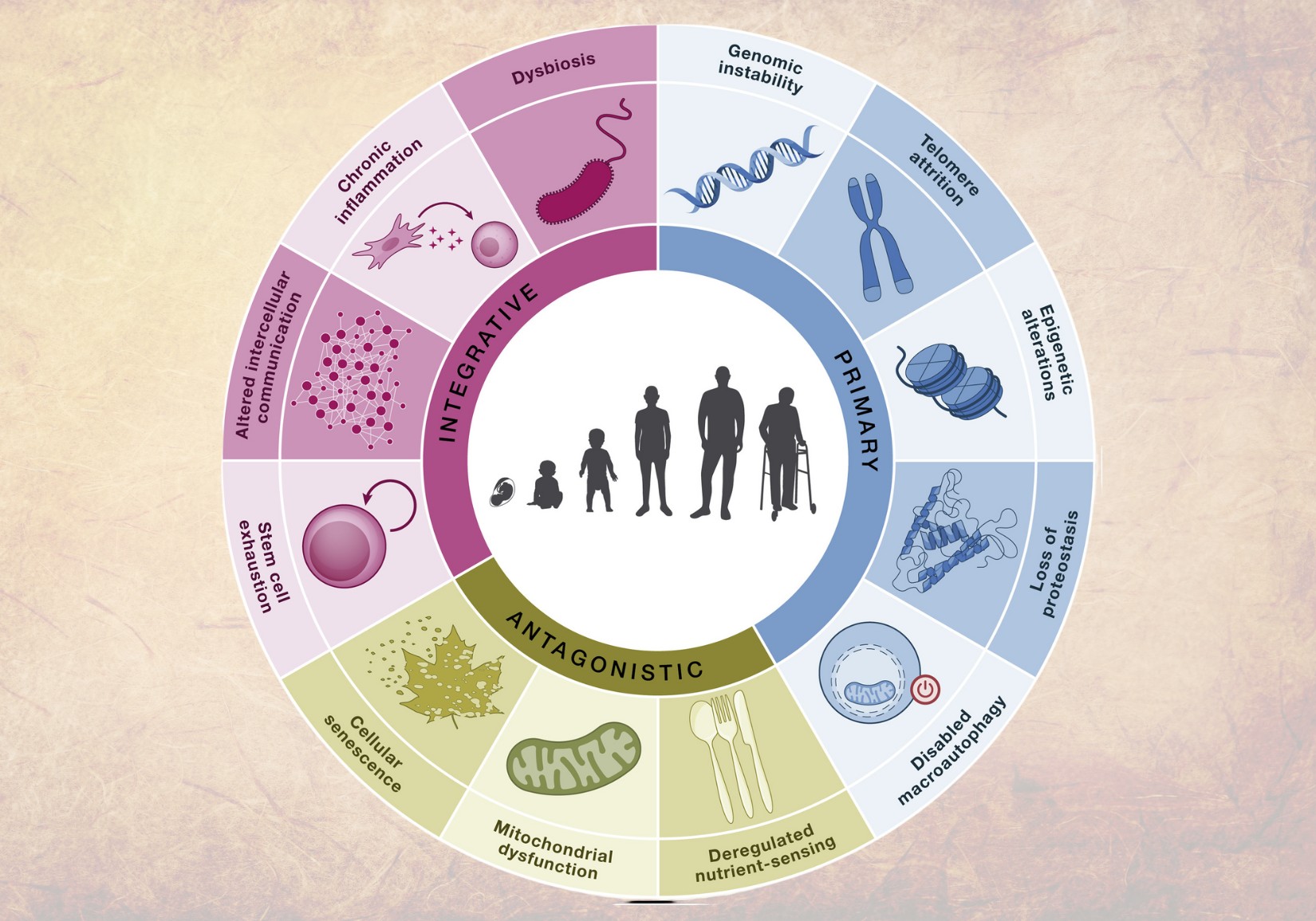#1 What Is Aging : Understanding 12 Hallmarks of Aging

Going in depth on the wiring behind our Biological Clocks by Dr Michael Eng.
Aging is a complex and inevitable biological process influenced by genetic, environmental, and metabolic factors. Undeniably, aging is our ‘age-old’ friend that marks each milestone with the wonders of our lives. But what exactly is aging?
Recent scientific advancements have identified several key mechanisms that contribute to aging, categorized into three major groups: Primary, Antagonistic, and Integrative hallmarks. These hallmarks interact with each other, leading to the progressive decline in physiological function observed with aging.
Primary Hallmarks – The Root Causes of Aging [1]
- Genomic Instability
As we age, DNA mutations accumulate due to environmental factors and internal errors due to the wear and tear of our own body and immune system. Hence, our body may experience an increased susceptibility to diseases such as cancer and neurodegeneration. - Telomere Attrition
Telomeres, the protective caps at the ends of chromosomes, shorten with each cell division. When they become critically short, cells enter senescence or apoptosis, contributing to aging.
- Senescence refers to the cell’s loss of power in division and growth. We’d commonly observe this through the worsening of our eyesight or development of wrinkles on our skin.
- Apoptosis [2] is a kind of cell death where a cell dies as a result of a sequence of molecular events. This is one way the body eliminates unwanted cells. Cancer cells may be unable to undergo apoptosis, resulting in events such as the persistence of malignant cells.
3. Epigenetic Alterations
This is a genetic alteration that alters gene expression but has no effect on the DNA sequence. To be specific, there would be changes in DNA methylation, histone modifications, and chromatin remodeling can disrupt gene expression and cellular function. All of which leads to aging-related diseases.
4. Loss of Proteostasis
Cells struggle to keep their proteins properly balanced and functional. When this happens, damaged or misfolded proteins start to build up instead of being repaired or removed. This accumulation is a key factor in aging and is linked to diseases like Alzheimer’s and Parkinson’s, where toxic protein clumps interfere with normal brain function.
5. Disabled Macroautophagy [3]
Cells rely on the natural cleanup process called macroautophagy to break down and recycle old or damaged parts. When this process is impaired, waste materials including defective proteins and cellular debris start piling up. Over time, this buildup disrupts normal cell function and also contributes to aging and diseases like Alzheimer’s and Parkinson’s.
Antagonistic Hallmarks – Cellular Responses That Can Become Detrimental
Initially, these hallmarks serve as compensatory systems that support the preservation of cellular homeostasis. They can, however, hasten ageing and aid in the advancement of disease when dysregulated or overproduced.
6. Cellular Senescence
Senescent cells stop dividing and accumulate, secreting inflammatory factors that contribute to tissue dysfunction and age-related diseases. Although at first a stress-reduction strategy, its persistence leads to chronic inflammation and impaired tissue regeneration.
7. Mitochondrial Dysfunction
Impairments in mitochondrial function reduce energy production and increase oxidative stress, leading to cellular damage. While mitochondria help regulate metabolism and stress responses, their dysfunction exacerbates aging-related decline.
8. Deregulated Nutrient-Sensing
As biological processes slow down, the body’s ability to properly detect and respond to nutrients becomes less efficient. Key systems that control energy use start to malfunction. When these systems are out of balance, it can lead to problems like diabetes, obesity, and other age-related diseases. Basically, the body struggles to manage energy and growth the way it once did, increasing the risk of metabolic disorders.
Integrative Hallmarks – Systemic Consequences of Aging
Integrative hallmarks result from the interaction of primary and antagonistic hallmarks and ultimately contribute to functional decline.
9. Stem Cell Exhaustion
Our body relies on stem cells to repair and regenerate tissues. With time, these stem cells become less effective, leading to slower healing, weaker bones, and a weaker immune system.
10. Altered Intercellular Communication [4]
Cells communicate with each other through chemical signals. This communication becomes less effective with aging, leading to chronic inflammation and a weaker immune system, making us more prone to infections and diseases.
11. Chronic Inflammation
Chronic inflammation is also called “inflammaging”. This refers to persistent, low-level inflammation throughout the body. Over time, this inflammation contributes to diseases like heart disease, diabetes, and arthritis.
12. Dysbiosis [5]
The bacteria in our gut play a crucial role in digestion, immunity, and overall health. The ratio of beneficial to harmful bacteria changes with age, which can result in immune system weakness, increased inflammation, and digestive problems.
Take Home Message
Understanding the hallmarks we’ve just discussed provides insight into potential interventions that may slow aging and promote longevity. Strategies such as caloric restriction, exercise, pharmacological agents and longevity medicine are being explored to mitigate the effects of aging.
By addressing these fundamental mechanisms, we can move closer to enhancing health span, delaying age-related diseases, and improving overall quality of life as we age.
References
[1] Bajnath, A. (2021, February 17). Genomic Instability – A Root Cause of Aging. https://ifho.org/genomic-instability-a-root-cause-of-aging/
[2] Cleveland Clinic. (2024, September 16). Apoptosis. https://my.clevelandclinic.org/health/articles/apoptosis
[3] Stoneham, K. (2024, August 3). Disabled macroautophagy – Hallmark of aging . Oxford Healthspan®. https://oxfordhealthspan.com/blogs/aging-well/disabled-macroautophagy-hallmark-of-aging-10
[4] GrowingLife Oxford. (2023, May 16). What is altered intercellular communication? . https://www.gowinglife.com/what-is-altered-intercellular-communication-the-hallmarks-of-ageing-series/
[5] Robinson, J. (n.d.). Dysbiosis. https://www.webmd.com/digestive-disorders/what-is-dysbiosis


